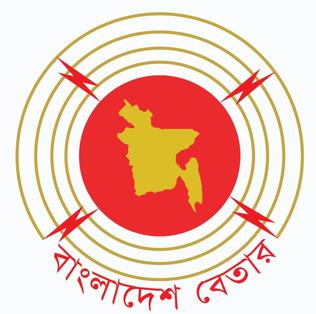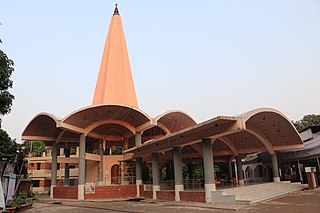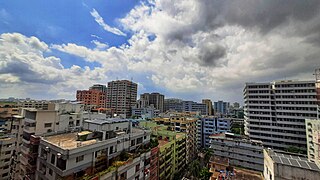
Dhaka, formerly known as Dacca, is the capital and largest city of Bangladesh. It is the ninth-largest and seventh-most densely populated city in the world. Dhaka is a megacity, and has a population of 10.2 million residents as of 2022, and a population of over 22.4 million residents in Dhaka Metropolitan Area. It is widely considered to be the most densely populated built-up urban area in the world. Dhaka is the most important cultural, economic, and scientific hub of Eastern South Asia, as well as a major Muslim-majority city. Dhaka ranks third in South Asia and 39th in the world in terms of GDP. Lying on the Ganges Delta, it is bounded by the Buriganga, Turag, Dhaleshwari and Shitalakshya rivers. Dhaka is also the largest Bengali-speaking city in the world.

Dhaka Division is an administrative division within Bangladesh. Dhaka serves as the capital city of the Dhaka Division, the Dhaka District and Bangladesh. The division remains a population magnet, covers an area of 20,508.8 km2 with a population in excess of 44 million, It is the most populous country second level division of the world, growing at 1.94% rate since prior count, compared with national average of 1.22%. However, national figures may include data skewing expatriation of male labor force as gender ratio is skewed towards females.

Suhrawardy Udyan is a national memorial and public space located in Dhaka, Bangladesh. Originally known as Ramna Race Course, it holds significant historical importance due to its association with key events in the country's history.

East Bengal was a non-contiguous province of the Dominion of Pakistan. Geographically eastern part of the Bengal region, East Bengal existed from 1947 until 1955, when it was renamed East Pakistan. Today, the area is an independent country, Bangladesh. With its coastline on the Bay of Bengal, it bordered India and Burma. It was located close to, but did not share a border with, Nepal, Tibet, the Kingdom of Bhutan and the Kingdom of Sikkim. It's capital was Dacca, now known as Dhaka.

Bangladesh Betar, or BB is the state-owned radio broadcaster of Bangladesh, initially established as the Dhaka station of All India Radio in 1939. It was later made part of Radio Pakistan. After the independence of the country in 1971, Radio Pakistan ceased transmissions there and the Swadhin Bangla Betar Kendra was renamed to Bangladesh Betar, which took full control of all radio stations in the country at the time.

Bailey Road is a well-known thoroughfare in Ramna, Dhaka, the capital city of Bangladesh.

The Ramna Kali Mandir is a temple in Dhaka that was originally built in the time of the Mughal Empire. It was also known as the "Ramna Kalibari". The temple is dedicated to the Hindu Goddess Kali.

Shahbagh is a major neighbourhood and a police precinct or thana in Dhaka, the capital and largest city of Bangladesh. It is also a major public transport hub. It is a junction between two contrasting sections of the city—Old Dhaka and New Dhaka—which lie, respectively, to its south and north. Developed in the 17th century during Mughal rule in Bengal, when Old Dhaka was the provincial capital and a centre of the flourishing muslin industry, it came to neglect and decay in early 19th century. In the mid-19th century, the Shahbagh area was developed as New Dhaka became a provincial centre of the British Raj, ending a century of decline brought on by the passing of Mughal rule.

Eastern Bengal and Assam was a province of India between 1905 and 1912. Headquartered in the city of Dacca, it covered territories in what are now Bangladesh, Northeast India and Northern West Bengal.
Motijheel is a central business district and a thana of Dhaka, Bangladesh. It is Dhaka's primary central business district. and also the nation's largest commercial and financial hub. Motijheel, Dhaka's zero point, has the largest number of offices in Dhaka. Motijheel CBD also has one of the highest concentrations of high-rise buildings in Bangladesh. It has thus earned the title of the downtown and city centre of Dhaka and as the bankpara-officepara in Bengali.
The Dhaka Club is the oldest recreation organisation and the largest of elite clubs in Dhaka. Originally it was an all-white association in British India.
Television is one of the most popular forms of media and information in Bangladesh. It was one of the first countries in South Asia to introduce television on 25 December 1964, in the then East Pakistan under the state-owned television network Pakistan Television Corporation in its capital, Dhaka. After the Bangladesh Liberation War in 1971, the Dhaka television station of PTV was renamed to Bangladesh Television, which had a monopoly on the country's television industry until 1997, with the launch of ATN Bangla on satellite television. Since then, the number of privately owned television channels saw a tremendous rise in the Bangladeshi television market.

1971 Dhaka University massacre refers to the massacre of students and faculty at the University of Dhaka in East Pakistan by the Pakistan Army, at the beginning of what would become the Bangladesh Liberation War. In March 1971, the Pakistan Army Eastern Wing Commander Tikka Khan launched Operation Searchlight on the orders of dictator Yahya Khan to crush the Bengali nationalist movement. As part of the operation, the army launched an assault on the university campus. It is the deadliest university attack in history.

The 7th March Speech of Bangabandhu, or the 7/3 Speech, was a public speech given by Sheikh Mujibur Rahman, the Founding Father of Bangladesh on 7 March 1971 at the Ramna Race Course in Dhaka to a gathering of over one million (1,000,000) people. It was delivered during a period of escalating tensions between East Pakistan and the powerful political and military establishment of West Pakistan. In the speech, Bangabandhu informally declared the independence of Bangladesh, proclaiming: "The struggle this time, is a struggle for our liberty. The struggle this time, is a struggle for our independence." He announced a civil disobedience movement in the province, calling for "every house to turn into a fortress".

Dhaka City Corporation (DCC) was the former self-governing corporation that was entrusted with the task of administering the municipal affairs of Dhaka. The incorporated area was divided into several wards. Each ward has an elected ward commissioner. The mayor of the city was elected by popular vote every five years, although the last mayoral election took place in 2002. The corporation was dissolved by the Local Government Amendment Bill 2011 on 29 November, passed in the Parliament of Bangladesh, and formally ceased to exist on 1 December 2011, following the President's approval, making way for a Dhaka North and a Dhaka South city corporations.
The following is a timeline of the history of the city of Dhaka, Bangladesh.
Nizam Mohammad Serajul Alam Khan, commonly known as Serajul Alam Khan, also called as Dada, Dadabhai and by his initials SAK, was a Bangladeshi politician, political analyst, philosopher and writer who spearheaded the Bangladesh liberation movement under the leadership of Sheikh Mujibur Rahman but also became one of the controlling forces of political polarization in post-independence Bangladesh.
The non-cooperation movement of 1971 was a historical movement in then East Pakistan by the Awami League and the general public against the military government of Pakistan in March of that year. After the announcement of the suspension of the session of the National Assembly of Pakistan on 1 March, the spontaneous movement of the people started, but officially on the call of Sheikh Mujibur Rahman, the non-cooperation movement started on 2 March and continued until 25 March. The movement lasted for a total of 25 days.

Dhaka, formerly known as Dacca, is the capital of Bangladesh. It is the ninth-largest and the sixth-most densely populated city in the world, with a population of 8.9 million residents within the city limits, and a population of over 21 million residents in the Greater Dhaka Area. Dhaka is the economic, political, and cultural center of Bangladesh, and is one of the major cities in South Asia, the largest city in Eastern South Asia.

Segunbagicha is an upscale residential, administrative, commercial, and institutional neighbourhood in south-central Dhaka. The neighbourhood is one of the important areas of Dhaka featuring a large number of government and residential complexes. It acts as a bridge between the major thanas of Ramna, Shahbagh, Dhanmondi, Paltan and Motijheel, and is located at the crossroads of Ramna, Shahbag and Paltan thanas.

















